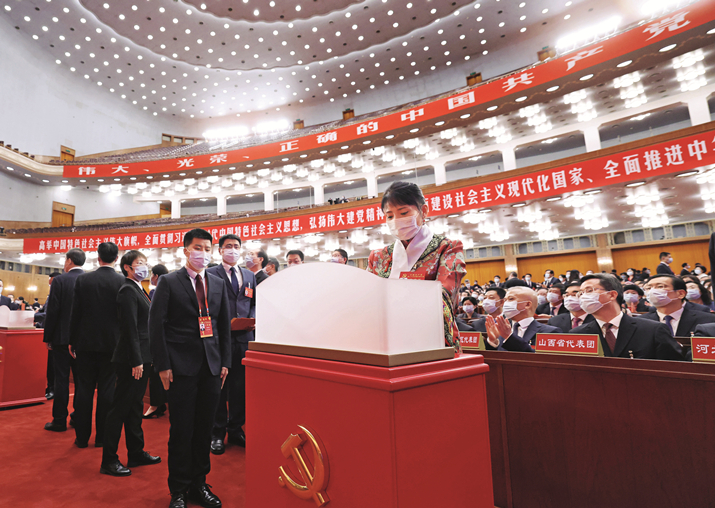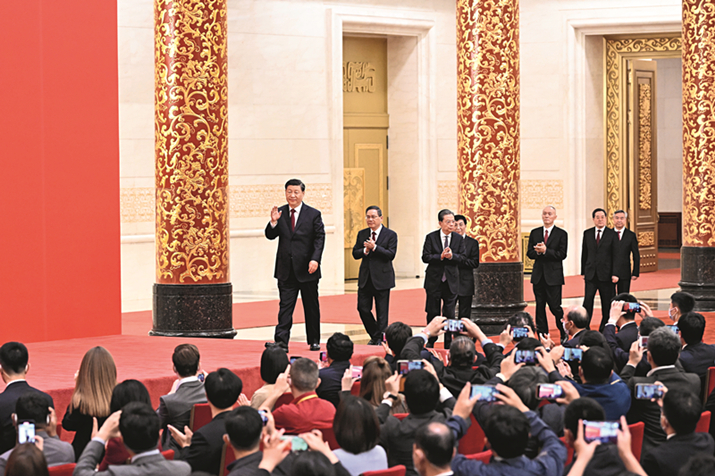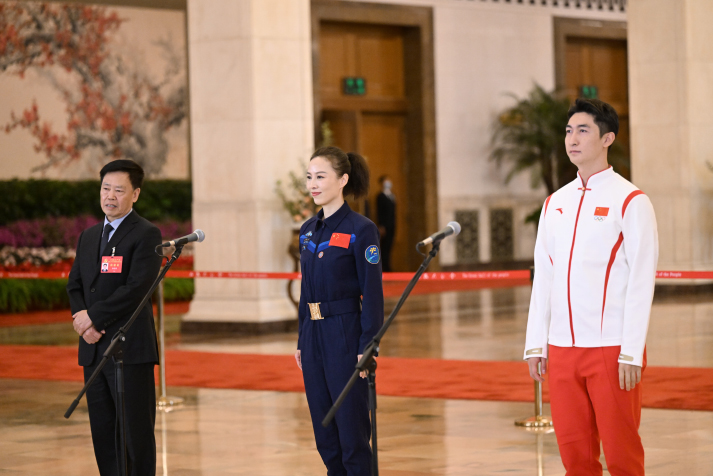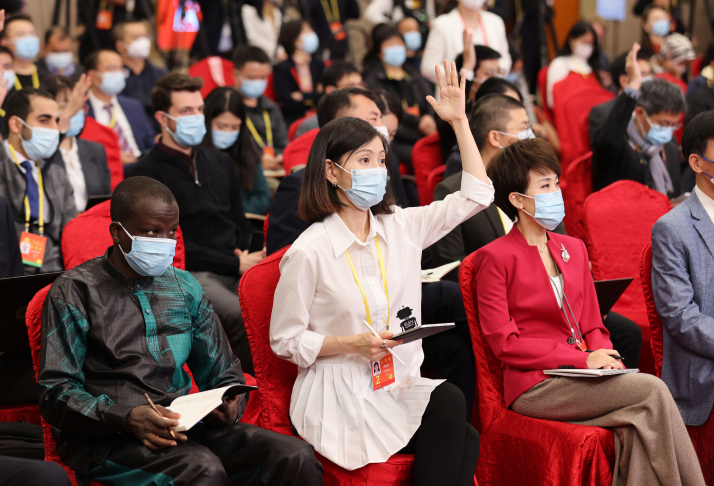|
||||||||||
| Home Nation World Business Opinion Lifestyle ChinAfrica Multimedia Columnists Documents Special Reports |
|
||||||||||
| Home Nation World Business Opinion Lifestyle ChinAfrica Multimedia Columnists Documents Special Reports |
| Current Cover Story |
| A Chinese Path to Modernisation |
| The 20th CPC National Congress charts new course for China’s development to advance national rejuvenation |
| By Lu Yan 丨VOL. 14 December 2022 ·2022-11-07 |

A delegate casts her ballot at the closing session of the 20th National Congress of the CPC in the Great Hall of the People in Beijing on 22 October
China’s push towards modernisation began when the Qing Dynasty (1644-1912), a feudal empire, started to crumble in the 19th century. Weak imperial authority and a highly corrupt civic infrastructure, in a country reduced to a semi-colonial, semi-feudal society following the Opium War of 1840, spurred people to start seeking new ways to pull the poor and weak nation together and change their fate through development and modernisation.
In his Plan for National Reconstruction written more than a century ago, Sun Yat-sen, the renowned Chinese statesman who led a revolution that ended more than 2,000 years of feudal rule in China, set forth a grandiose plan for China’s industrialisation, designed by him without much help from engineers or economists. Unfortunately, that plan failed to deliver.
In 1921, the Communist Party of China (CPC) was born. Since then, it has led the Chinese people to successfully achieve national independence and eliminate absolute poverty. It has been adjusting its priorities for different historical periods in light of the national realities and requirements of the times.
Today, it has charted a course for Chinese-style modernisation. “From this day forward, the central task of the CPC will be to lead the Chinese people of all ethnic groups in a concerted effort to realise the Second Centenary Goal of building China into a great modern socialist country in all respects and to advance the rejuvenation of the Chinese nation on all fronts through a Chinese path to modernisation,” Xi Jinping, General Secretary of the CPC Central Committee and Chinese President, said in a report he delivered at the opening ceremony of the 20th CPC National Congress on 16 October.

Xi Jinping, General Secretary of the CPC Central Committee, and other newly elected members of the Standing Committee of the Political Bureau of the 20th CPC Central Committee Li Qiang, Zhao Leji, Wang Huning, Cai Qi, Ding Xuexiang and Li Xi arrive to meet the press at the Great Hall of the People in Beijing on 23 October
A customised path
The world’s most populous country now stands ready to embrace a modernisation model with its own characteristics. Xi said China’s modernisation offers humanity a new option to achieve modernisation.
Chinese-style modernisation is the modernisation of a huge population, of common prosperity for all, of material and cultural-ethical advancement, of harmony between humanity and nature and of peaceful development, Xi elaborated.
The model contains elements common to the modernisation processes of all countries, but it is more characterised with features unique to the Chinese context, Xi said at the latest CPC National Congress.
“Xi expounds on the distinctive characteristics of Chinese-style modernisation and reveals its fundamental difference from Western modernisation,” Ye Xiaowen, deputy director of the Committee on Culture, Historical Data and Studies of the National Committee of the Chinese People’s Political Consultative Conference, said.
With the First Industrial Revolution that began in the 18th century, Western capitalist countries started developing, striding ahead of other countries in terms of productivity. Their modes of production did show their advantages, but this doesn’t mean there is only one path to modernisation, Yin Jun, a research fellow with the National School of Development under Peking University, said.
China is home to 1.4 billion people, more than the combined population of all modernised countries by current definition. “Our modernisation benefits everyone in the country - instead of just a few,” Gao Derong, a delegate to the CPC National Congress from a rural area of Yunnan Province, told Xinhua News Agency. China’s success in eradicating absolute poverty over recent years is a major step towards attaining a key goal of Chinese modernisation: common prosperity.
“The overall modernisation of a population of more than 1.4 billion is unprecedented in human history, and is bound to call for greater efforts to overcome more difficulties and will inevitably have a broader, worldwide impact and better contribute to the cause of human progress,” Han Wenxiu, an official with the CPC Central Committee for Financial and Economic Affairs said, adding that the country must come up with new initiatives to narrow the development gaps between different regions, between rural and urban areas, and among different income groups. It’s not a matter of pursuing equalitarianism, but one of assigning more importance to equal opportunities and balanced resource allocation.
In the meantime, ecological conservation features high on the modernisation agenda. “Respecting, adapting to and protecting nature is essential for building China into a modern socialist country in all respects… We must remember to maintain harmony between humanity and nature when planning our development,” Xi further said at the opening session.
China has actively participated in global environmental governance and international cooperation to address climate change and has promised to peak its carbon dioxide emissions before 2030 and achieve carbon neutrality before 2060.
“Unlike some Western countries, which have long followed the law of the jungle and the confrontational zero-sum game logic that a country will invariably seek hegemony when it grows strong, China adheres to the path of peaceful development while pursuing Chinese-style modernisation,” Ye explained.
Adham Sayed, a member of the Central Committee of the Lebanese Communist Party, said that as today’s world is going through a phase of transformation and the global order is undergoing fundamental changes, humanity needs a clear plan, and an alternative and a new world order based on addressing the world’s crises. “China’s messages give hope to the people of the world that the future will be better, and that a strong China means a better world,” Sayed told Beijing Review.
“There was a tremendous sense of ‘things coming together’ in Xi’s speech, a vision for China in the world being elaborated through actual accomplishments and concrete plans,” John Pang, a senior fellow at Bard College in New York, told Beijing Review. “It was animated, not by any reference to external threats, but by the vision of national rejuvenation and the call to build a Chinese socialist civilisation within a shared community for humanity.”

Delegates to the 20th CPC National Congress attend an interview at the Great Hall of the People in Beijing on 16 October
Solid steps
A Chinese path to modernisation has taken shape over the course of more than a century of exploration, Gong Weibin, vice president of the Party School of the CPC Central Committee, told The Beijing News. Gong said that before the founding of the People’s Republic of China in 1949, some people had attempted to transform China into a modern country by focusing on generating material wealth, carrying out institutional reform, or trying to copy Western development models. But they were all running in circles.
The CPC has guided the Chinese people in making historic progress, one step at a time. During the First Session of the Third National People’s Congress, from 21 December 1964 to 4 January 1965, then Premier Zhou Enlai emphasised the importance of turning China into a strong socialist country through the modernisation of agriculture, industry, national defence, and science and technology.
The Third Plenary Session of the 11th CPC Central Committee in 1978 was a landmark event, as it paved the way to China’s reform and opening up.
In 1987, the Party laid out its Three-Step Development Strategy for the country’s modernisation. The first step was to double the 1980 GNP and ensure the people had enough food and clothing. That objective had been attained by the late 1980s. The second step was to quadruple the 1980 GNP by the end of the 20th century. This was achieved in 1995, ahead of time. The third step, then, is to increase the per-capita GNP to the level of the medium-developed countries by the mid-21st century. Then the people will be well-off, and modernisation will be basically realised.
“With these explorations, the Chinese path to modernisation becomes increasingly clear,” Gong said.
In Xi’s speech at the ceremony marking the CPC’s centenary on 1 July 2021, he declared “through the continued efforts of the whole Party and the entire nation, we have realised the First Centenary Goal of building a moderately prosperous society in all respects. This means that we have brought about a historic resolution to the problem of absolute poverty in China, and we are now marching in confident strides towards the Second Centenary Goal of building China into a great modern socialist country in all respects.”
As the 20th CPC National Congress opened, the CPC unveiled its blueprint for building a modern socialist China in all respects for the next five years and beyond.
The CPC aims to basically realise socialist modernisation from 2020 through 2035; and build China into a great modern socialist country that is prosperous, strong, democratic, culturally advanced, harmonious and beautiful from 2035 through the middle of this century.

Journalists at a group interview with spokespersons of multiple provincial-level delegations on the sidelines of the 20th CPC National Congress in Beijing on 19 October
Engaging the people
The CPC National Congress is the highest decision-making body of the Party. This year it was convened from 16 to 22 October.
Some 2,300 delegates attended the congress, including Party and government leaders, military officers and Party members from the primary level such as farmers, technicians, nurses and teachers. Together, they represent more than 96 million CPC members and over 4.9 million primary-level Party organisations.
Their duties at the congress include hearing and examining the report of the 19th CPC Central Committee to the congress, hearing a work report of the 19th CPC Central Commission for Discipline Inspection, deliberating and adopting an amendment to the CPC Constitution, and electing the 20th CPC Central Committee and the 20th CPC Central Commission for Discipline Inspection. Following the congress’ conclusion, the 20th CPC Central Committee held its first plenary session, during which highest-ranking Party leaders including the general secretary of the CPC Central Committee were elected.
The opinions of more than 4,700 people had been collected in order to formulate the draft report of the 19th CPC Central Committee before it was delivered at the 20th CPC National Congress, according to Xie Chuntao, vice president of the Party School of the CPC Central Committee. “The degree of attention paid by the CPC Central Committee, the efforts exerted, and the participation of the whole Party are rare, or even non-existent, in other countries - as far as I know,” Xie told Beijing Review.
“We will encourage the people’s orderly participation in political affairs and guarantee their ability to engage in democratic elections, consultations, decision-making, management, and oversight in accordance with the law,” the report to the 20th CPC National Congress states.
The report points out that “People’s democracy is the lifeblood of socialism and is integral to our efforts to build a modern socialist country in all respects.” It further details that “all power of the state in China belongs to the people,” and “we will support and ensure the people’s exercise of state power through people’s congresses.”
The National People’s Congress is the highest organ of state power. Local people’s congresses at all levels act as local agencies of state power. All administrative, supervisory, judicial and procuratorial organs of the state are created by the people’s congresses, to which they are responsible and by which they are supervised.
Over 2.62 million people served as deputies to people’s congresses at all levels nationwide, including some 3,000 at the national level. Deputies to people’s congresses are not necessarily Party members.
At the National People’s Congress sessions, usually held in March each year, deputies gather to discuss plans for national development and problems affecting people’s lives. They guarantee the people’s expectations are at the top of the agenda.
“We must firmly stay on the path of socialist political advancement with Chinese characteristics, uphold the unity between Party leadership, the running of the country by the people and law-based governance, and ensure the principal position of the people, so as to give full expression to their will, protect their rights and interests, and spark their creativity,” the report reads.
(Yuan Yuan, Li Fangfang, Tao Xing and Ma Miaomiao contributed to this article)
| About Us | Contact Us | Advertise with Us | Subscribe |
| Copyright Beijing Review All rights reserved 京ICP备08005356号-5 京公网安备110102005860号 |